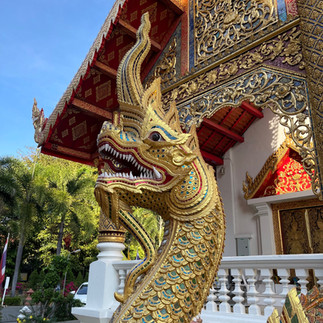Wat Phra Singh Temple, Chiang Mai
- Walter Ponce
- Sep 18, 2023
- 3 min read
Wat Phra Singh is perhaps the second most revered temple in Chiang Mai after Wat Phra That Doi Suthep. It is usually busy with visitors and worshipers throughout the year, although it is most crowded during the Thai New Year festival (Songkran) in mid-April. It provides an excellent opportunity to learn about the art and architecture of the Lanna style temples, as although most of the buildings within it have undergone various renovations, they still retain the original feel.
Wat Phra Singh can be found in the historical walled city center of Chiang Mai, situated at the western terminus of Ratchadamnoen Road. Within the same ancient walled city, in close proximity, you'll also discover Wat Chedi Luang and Wat Chiang Man.
For a comprehensive understanding of the must-see highlights at Wat Phra Singh, it's important to note that this temple encompasses three primary structures, with the focal point being the Lai Kam room. The Lai Kam room boasts exquisite adornments and houses meticulously restored murals depicting the daily lives of local inhabitants from centuries past, as well as scenes from the Jataka, the original Indian narratives recounting the Buddha's prior incarnations. Erected in 1345 and later refurbished in the early 19th century, it serves as an exemplary representation of Lanna temple architecture, featuring lofty, wing-shaped ceilings and opulent wooden carvings. In essence, it stands as one of the finest specimens of this architectural style in northern Thailand.
Inside the Lai Kam hall, you'll encounter Phra Singh, the Lion Buddha—an immensely venerated Buddha image characterized by the graceful "Lion" style, influenced by the Sukhothai and Indian Pala traditions. This is why Wat Phra Singh is also known as "The Monastery of the Lion Buddha" or "The Temple of the Lion Buddha."
Viharn Luang, the largest hall, shelters a Buddha image crafted from copper and gold, dating back to the 15th century. Although originally constructed towards the end of the 14th century, it underwent complete reconstruction in 1925 on its original site. While impressive in its own right, the interior decorations here are less ornate compared to those found in Viharn Lai Kam. Inside, you'll encounter the highly esteemed Buddha image known as Phra Chao Thong Tip—a golden and copper seated Buddha displaying the subdued Mara mudra, created in 1477.
Another noteworthy structure is the Library (Haw Trai), positioned on a stone pedestal to the left of Viharn Lai Kam. This red wooden hall is adorned with exquisite stucco figures and safeguards Buddhist scriptures. Its construction dates back to the late 15th century, and the decision to elevate it on a stone base was made to safeguard the manuscripts from floods and pests. The base itself is lavishly embellished with carvings of Devata figures, akin to guardian angels.
It is an active temple, with hundreds of monks and novices living there. During the Songkran festival in April, when the traditional Asian New Year is celebrated, the image of Phra Singh is paraded through the streets of Chiang Mai, and it is customary for local people to honor the image by sprinkling it with water.
Practical information
Opening and closing hours: Opening hours are 6 am and closing hours are 5 pm.
Appropriate clothing: As in any religious temple, it is best to wear conservative style clothing to respect customs and avoid problems or offenses. Keep in mind, also, that it is one of the most revered temples in the city and the country. Men must wear long pants and women pants or skirts that cover at least the knee. In addition, you must wear a shirt with sleeves to have your shoulders covered.
You can get there on foot if you are in the vicinity of the ''Old City'' of Chiang Mai. If not, you can take a tuk tuk or a taxi that will drop you off directly at your destination. If you have a bicycle or scooter, I definitely recommend these means of transportation to get to the temple.
In conclusion, Wat Phra Singh stands as one of the most esteemed temples in Chiang Mai, second only to Wat Phra That Doi Suthep in reverence. It remains a bustling hub for visitors and devotees year-round, with its peak during the vibrant Thai New Year festival, Songkran, in mid-April. This temple offers a captivating journey into the art and architecture of Lanna-style temples. Despite various renovations, the original essence of these structures perseveres, providing a valuable glimpse into Northern Thailand's architectural heritage. With its rich history, remarkable structures like the Lai Kam room and Viharn Luang, and its role as home to a vibrant monastic community, Wat Phra Singh is a cultural treasure in the heart of Chiang Mai's old city. Visitors should also be mindful of dressing conservatively to respect local customs, and opening hours for the temple are from 6 am to 5 pm. Whether arriving on foot, by tuk-tuk, taxi, bicycle, or scooter, a visit to Wat Phra Singh promises a rewarding cultural experience in Chiang Mai.












コメント